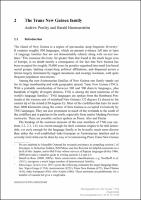Chapter 2 The Trans New Guinea family
| dc.contributor.author | Pawley, Andrew | |
| dc.contributor.author | Hammarström, Harald | |
| dc.contributor.editor | Palmer, Bill | |
| dc.date.accessioned | 2019-11-19 23:55 | |
| dc.date.accessioned | 2020-01-07 16:47:06 | |
| dc.date.accessioned | 2020-04-01T09:26:48Z | |
| dc.date.available | 2020-04-01T09:26:48Z | |
| dc.date.issued | 2017 | |
| dc.identifier | 1006425 | |
| dc.identifier | OCN: 1135847480 | en_US |
| dc.identifier.uri | http://library.oapen.org/handle/20.500.12657/23719 | |
| dc.description.abstract | The island of New Guinea is a region of spectacular, deep linguistic diversity.1It contains roughly 850 languages, which on present evidence fall into at least 18 language families that are not demonstrably related, along with several iso-lates.2 This immense diversity, far greater than that found in the much larger area of Europe, is no doubt mainly a consequence of the fact that New Guinea has been occupied for roughly 50,000 years by peoples organised into small kin-based social groups, lacking overarching political affiliations, and dispersed across a terrain largely dominated by rugged mountains and swampy lowlands, with quite frequent population movements. Among the non-Austronesian families of New Guinea one family stands out for its large membership and wide geographic spread: Trans New Guinea (TNG). With a probable membership of between 300 and 500 discrete languages, plus hundreds of highly divergent dialects, TNG is among the most numerous of the world’s language families.3 TNG languages are spoken from the Bomberai Pen-insula at the western end of mainland New Guinea (132 degrees E) almost to the eastern tip of the island (150 degrees E). Most of the cordillera that runs for more than 2000 kilometers along the centre of New Guinea is occupied exclusively by TNG languages. They are also prominent in much of the lowlands to the south of the cordillera and in patches to the north, especially from central Madang Province eastwards. There are possible outliers spoken on Timor, Alor and Pantar. | |
| dc.language | English | |
| dc.subject.classification | thema EDItEUR::C Language and Linguistics | en_US |
| dc.subject.classification | thema EDItEUR::C Language and Linguistics::CF Linguistics | en_US |
| dc.subject.classification | thema EDItEUR::G Reference, Information and Interdisciplinary subjects::GT Interdisciplinary studies::GTM Regional / International studies | en_US |
| dc.subject.other | Papuan Languages | |
| dc.subject.other | Linguistic Typology | |
| dc.subject.other | Language Contact | |
| dc.title | Chapter 2 The Trans New Guinea family | |
| dc.type | chapter | |
| oapen.identifier.doi | 10.1515/9783110295252-002 | |
| oapen.relation.isPublishedBy | 2b386f62-fc18-4108-bcf1-ade3ed4cf2f3 | |
| oapen.relation.isPartOfBook | 50680ea5-8a11-4715-9a0c-09df22349411 | |
| oapen.relation.isFundedBy | 7292b17b-f01a-4016-94d3-d7fb5ef9fb79 | |
| oapen.relation.isbn | 9783110286427; 9783110567267 | |
| oapen.collection | European Research Council (ERC) | * |
| oapen.collection | EU collection | * |
| oapen.place.publication | Berlin/Boston | |
| oapen.grant.number | 230310 | |
| oapen.grant.acronym | CONTACTS | |
| oapen.identifier.ocn | 1135847480 |

